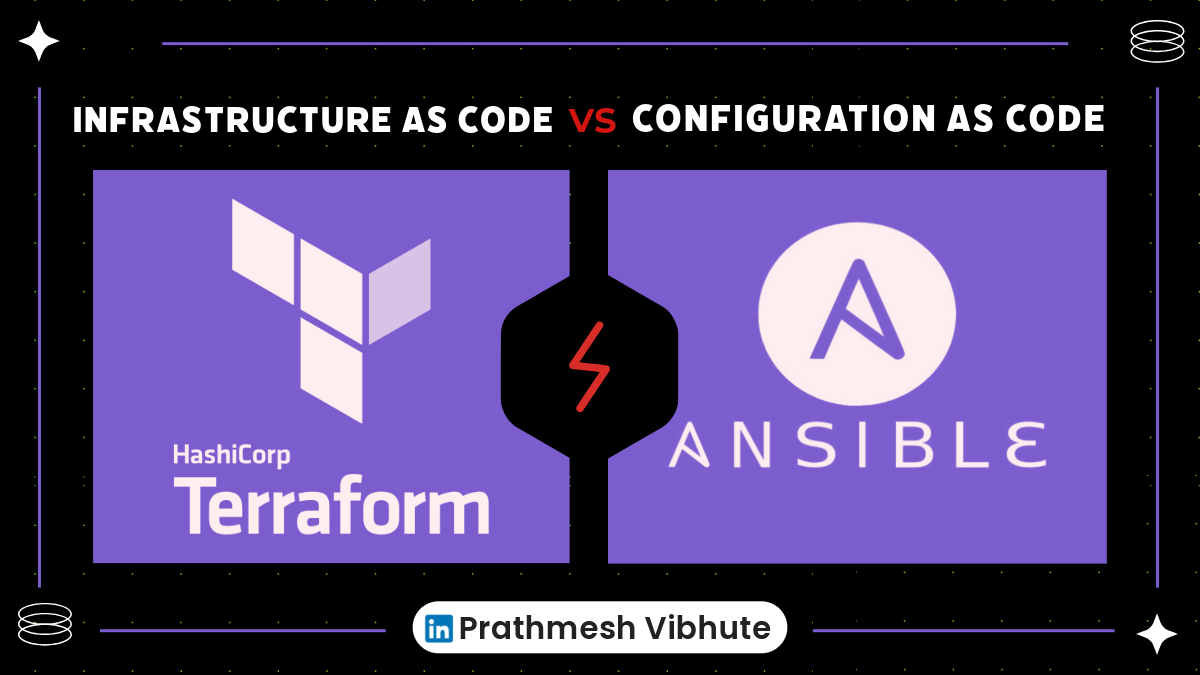Day 54 : Understanding Infrastructure as Code and Configuration Management
 Prathmesh Vibhute
Prathmesh Vibhute
What's the difference?
When it comes to the cloud, Infrastructure as Code (IaC) and Configuration Management (CM) are inseparable. With IaC, a descriptive model is used for infrastructure management. To name a few examples of infrastructure: networks, virtual computers, and load balancers. Using an IaC model always results in the same setting.
Throughout the lifecycle of a product, Configuration Management (CM) ensures that the performance, functional and physical inputs, requirements, design, and operations of that product remain consistent.
Task-01
1)Read more about IaC and Config. Management Tools
Infrastructure as Code (IaC) refers to the process of defining and managing infrastructure, such as servers, networks, and storage, through machine-readable files. This means that instead of manually configuring infrastructure, IaC tools enable teams to automate the provisioning and management of infrastructure using code. This approach allows teams to treat infrastructure as code, which can be version-controlled, tested, and integrated into a continuous delivery pipeline.
IaC manages infrastructure using a descriptive model. Infrastructure includes networks, virtual machines, load balancers, to name a few. An IaC model produces the same environment every time it is applied.
Configuration Management (CM) Tools, on the other hand, are used to automate the configuration and management of software applications running on the infrastructure. They help teams to maintain consistency across different environments by automating the configuration of software components and ensuring that configurations are applied consistently across all instances of an application.
Configuration Management (CM) maintains the consistency of an application’s performance, as well as its functional and physical inputs along with requirements, overall design, and operations throughout the lifespan of the product.
2)Give differences on both with suitable examples
The main difference between Infrastructure as Code (IaC) and Configuration Management (CM) is that IaC focuses on managing and provisioning infrastructure through code, while CM focuses on automating the configuration and management of software applications, operating systems, and servers. IaC tools focus on infrastructure management, while CM tools focus on software configuration management.
Infrastructure as Code (IaC) is a practice of managing and provisioning IT infrastructure through code. IaC allows teams to manage infrastructure in a repeatable, scalable, and automated manner. With IaC, infrastructure components such as virtual machines, networks, and storage can be defined as code, which can be version controlled, tested, and deployed like any other codebase.
Configuration Management (CM), on the other hand, is the practice of automating the configuration and management of software applications, operating systems, and servers. CM tools help teams automate the installation and configuration of software packages, enforce security policies, and manage system settings.
While IaC focuses on the infrastructure layer, CM focuses on the application layer. However, both concepts work together to help teams automate and manage their IT infrastructure more efficiently.
3)What are most common IaC and Config management Tools?
Some common Infrastructure as code tools include:
1)Terraform: A popular IaC tool that enables teams to manage infrastructure resources such as servers, networks, and storage in a declarative way using a simple language called HashiCorp Configuration Language (HCL).
2)Pulumi - A tool for creating, deploying, and managing infrastructure on any cloud using your favorite languages.
3)AWS CloudFormation: A service provided by Amazon Web Services (AWS) that enables teams to define and manage infrastructure resources as code using templates. CloudFormation supports several AWS services and enables teams to create and manage complex architectures.
4)Google Cloud Deployment Manager: A service provided by Google Cloud Platform (GCP) that enables teams to define and manage GCP resources as code using YAML or JSON templates.
5)Azure Resource Manager: A service provided by Microsoft Azure that enables teams to manage infrastructure resources using JSON templates.
Some common Configuration Management tools include:
1)Ansible: A popular CM tool that enables teams to automate the configuration and management of software applications. Ansible uses a simple language called YAML to define configurations and supports several operating systems and cloud providers.
2)Chef - A configuration management tool that automates the deployment, configuration, and management of software.
3)Puppet - A configuration management tool that helps automate the management of infrastructure, applications, and compliance.
4)SaltStack - A tool that automates the configuration and management of software applications, operating systems, and servers.
IaC and CM are complementary concepts that help teams automate and manage their IT infrastructure more efficiently. While IaC focuses on the infrastructure layer, CM focuses on the application layer. Some common IaC tools include Terraform, CloudFormation, Ansible, and Pulumi, while common CM tools include Chef, Puppet, SaltStack, and Ansible.
I'm confident that this article will prove to be valuable, helping you discover new insights and learn something enriching .
thank you : )
Subscribe to my newsletter
Read articles from Prathmesh Vibhute directly inside your inbox. Subscribe to the newsletter, and don't miss out.
Written by
